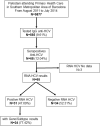Prevalence of Hepatitis C Virus Infection, Genotypes and Subtypes in Migrants from Pakistan in Barcelona, Spain
- PMID: 36003985
- PMCID: PMC9394658
- DOI: 10.2147/IDR.S367715
Prevalence of Hepatitis C Virus Infection, Genotypes and Subtypes in Migrants from Pakistan in Barcelona, Spain
Abstract
Background: Hepatitis C virus (HCV) is a major cause of chronic liver infection with 71 million people infected worldwide. Pakistan has the second highest prevalence of HCV infection and more than half (52%) of Pakistani living in Spain reside in Barcelona. The aim of this study was to analyse the seroprevalence and viraemic rate and determine the genotypes and subtypes of HCV among Pakistanis living in the southern metropolitan area of Barcelona.
Methods: We included all Pakistani patients seeking primary healthcare in the southern metropolitan area of Barcelona from August 2011 to July 2014. Serum samples were screened for HCV antibodies. HCV viral load was determined by reverse transcription polymerase chain reaction and genotypes and subtypes were performed using Versant HCV Genotype and/or deep-sequencing. Screening for hepatitis B virus (HBV) was also carried out.
Results: Among 5877 Pakistani patients, 565 (9.61%) were screened for anti-HCV antibodies, with 68 (12.04%) being positive. The viral load was determined in 65, with 31 presenting active infection and the viraemic rate was 47.69% (95% confidence interval 36.02-59.62). HCV genotyping and subtyping were performed in 24 individuals. Most infections corresponded to HCV genotype 3 (91.67%), and high resolution HCV subtyping was performed in 18 samples, 16 of which presented subtype 3a. One subject presented HBV coinfection with undetectable HBV DNA. During the study period, we identified a possible case of HCV vertical transmission followed by spontaneous viraemia clearance in a chronically infected mother with a C/T IL28B genetic polymorphism.
Conclusion: These results suggest that general HCV screening protocols in patients from high prevalence countries, such as Pakistan, would be helpful to identify and treat active HCV infections. This could avoid further transmission and contribute to building targeted health policies for micro-elimination of HCV infection in specific communities.
Keywords: HCV genotype; HCV subtype; hepatitis C virus; migrants.
© 2022 Dopico et al.
Conflict of interest statement
The authors report no conflicts of interest in this work.
Figures
Similar articles
-
High HCV subtype heterogeneity in a chronically infected general population revealed by high-resolution hepatitis C virus subtyping.Clin Microbiol Infect. 2017 Oct;23(10):775.e1-775.e6. doi: 10.1016/j.cmi.2017.02.007. Epub 2017 Feb 10. Clin Microbiol Infect. 2017. PMID: 28192235
-
Molecular epidemiology and viral load of HCV in different regions of Punjab, Pakistan.Virol J. 2014 Feb 10;11:24. doi: 10.1186/1743-422X-11-24. Virol J. 2014. PMID: 24512668 Free PMC article.
-
Prevalence of hepatitis B and C in internally displaced persons of war against terrorism in Swat, Pakistan.Eur J Public Health. 2011 Oct;21(5):638-42. doi: 10.1093/eurpub/ckq084. Epub 2010 Jul 3. Eur J Public Health. 2011. PMID: 20601693
-
Global epidemiology of hepatitis C virus infection: An up-date of the distribution and circulation of hepatitis C virus genotypes.World J Gastroenterol. 2016 Sep 14;22(34):7824-40. doi: 10.3748/wjg.v22.i34.7824. World J Gastroenterol. 2016. PMID: 27678366 Free PMC article. Review.
-
Coinfection of Schistosoma Species with Hepatitis B or Hepatitis C Viruses.Adv Parasitol. 2016;91:111-231. doi: 10.1016/bs.apar.2015.12.003. Epub 2016 Feb 5. Adv Parasitol. 2016. PMID: 27015949 Review.
Cited by
-
Primary healthcare as a strategy for eliminating hepatitis C: the METRIC toolkit.Prim Health Care Res Dev. 2024 Nov 7;25:e61. doi: 10.1017/S1463423624000355. Prim Health Care Res Dev. 2024. PMID: 39508085 Free PMC article.
References
-
- World Health Organization. Hapatitis C. Available from: https://www.who.int/news-room/fact-sheets/detail/hepatitis-c. Accessed August 3, 2022.
-
- Assembly UNG. Transforming our world: the 2030 Agenda for sustainable development. Resolution A/RES/70/1; 2016. Available from: Http://Www.Un.Org/Ga/Search/View_doc.Asp?Symbol=A/RES/70/1&Lang=E. Accessed August 3, 2022.
-
- Razavi H, Robbins S, Zeuzem S, European Union HCV collaborators. Hepatitis C virus prevalence and level of intervention required to achieve the WHO targets for elimination in the European Union by 2030: a modelling study. Lancet Gastroenterol Hepatol. 2017;2(5):325–336. doi:10.1016/S2468-1253(17)30045-6 - DOI - PubMed
-
- Corma-Gomez A, Pineda JA. Hepatitis C virus infection in Spain: challenges in the track to elimination. Enferm Infecc Microbiol Clin. 2019;37(4):219–221. - PubMed



